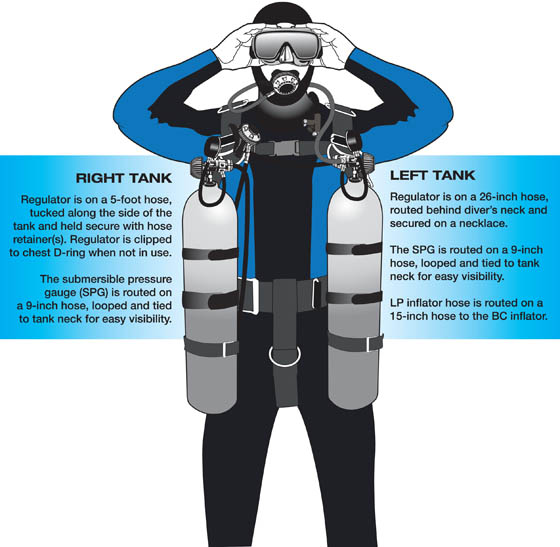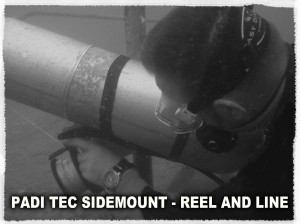Tec Sidemount Course, What is all about?
Sidemount Diving is configuring the diver’s cylinder(s) to the diver’s sides, under the arms, rather than on the back. Sidemount diving is well suited to a lot of different environments. If you have been diving with a tank on your back some divers who have physical limitations prefer Sidemount Diving over wearing back mounted cylinders. Sidemount diving equipment configured gives total freedom of movement, without restriction now your a sidemount diver. For technical divers, tec sidemount diver it is more convenient for travelling when double cylinders aren’t available. It is popular for cave or wreck diving and single cylinders are easier to haul when divers must carry sidemount gear through rough terrain to the water’s edge.
 PADI Tec Sidemount Course Diving Speciality Cyprus
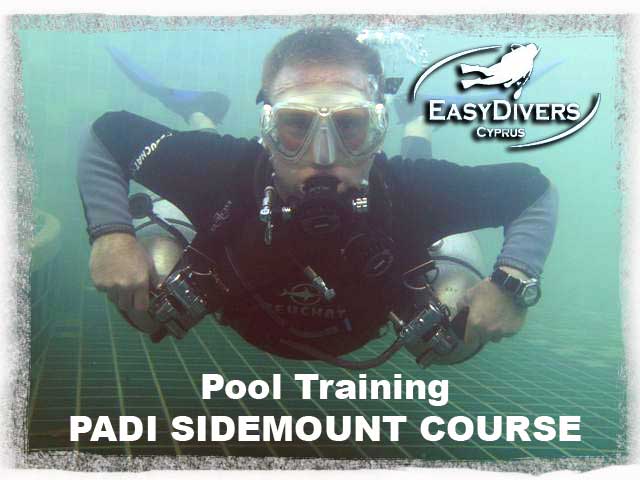 PADI Sidemount Diver Courses is a unique way of buoyancy control and streamlining. PADI Sidemount Diving gives you total freedom in a Side Mount Diving Harness that will reduce drag making fining and moving through the water easier and more efficient. Side mount Two tanks are better than one, when placed under each arm. PADI Sidemount Diving scuba are two independent tanks mounted and sidemount regulators on each side of your body NOT like heavy twin sets that can add to back problems.  When you take youe Tec Sidemount Course in cyprus we will show you proper sidemount diving hose routing, explanation of sidemount equipment and practical sidemount diving both in confine and openwater. This is not a technical diving course, Tec Sidemount Course is aimed is to show you how recreational divings a unique diving experience with two independent tanks (Side Mount Tanks)a small buoyancy device. By the end of this course you will be completely HOOKED on dive sidemount. Padi TecRec Technical Sidemount Course diving Tec Sidemount Diver training is also available too.
PADI Sidemount Diver Courses is a unique way of buoyancy control and streamlining. PADI Sidemount Diving gives you total freedom in a Side Mount Diving Harness that will reduce drag making fining and moving through the water easier and more efficient. Side mount Two tanks are better than one, when placed under each arm. PADI Sidemount Diving scuba are two independent tanks mounted and sidemount regulators on each side of your body NOT like heavy twin sets that can add to back problems.  When you take youe Tec Sidemount Course in cyprus we will show you proper sidemount diving hose routing, explanation of sidemount equipment and practical sidemount diving both in confine and openwater. This is not a technical diving course, Tec Sidemount Course is aimed is to show you how recreational divings a unique diving experience with two independent tanks (Side Mount Tanks)a small buoyancy device. By the end of this course you will be completely HOOKED on dive sidemount. Padi TecRec Technical Sidemount Course diving Tec Sidemount Diver training is also available too.
What will I learn when Sidemount Diving
- Equipment considerations
- Side Mount Diving Harness (Razor, Hollis, Dive Rite, UTD)
- Sidemount Diving Regulators (Apex, Mares, Scubapro)
- Air management
- Attaching cylinders
- Trim and Buoyancy Skills
- Fining techniques
- Deployment of surface marker
- Different water entries
- Side mount equipment
- Harness selection is custom fit to each individual
ALL SIDEMOUNT DIVING SKILLS ARE PERFORMED OFF THE BOTTOM – MID WATER
What is Sidemount Diving all about?
Good for a diver with disabilities such as back problems as you carry the cylinders separate from your harness to the water. You attach your cylinders once in the water or outside the water. This makes entries and exits to dive sites and RIB boat diving much easier. When boat diving the cylinders we simply taken off and handed to the boat crew. 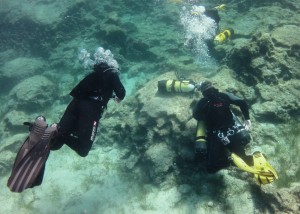 Learn how to configure equipment. One harness and BCD can do it all. The equipment you use can be used for more advanced types of diving; Padi Deep, Padi Wreck, Cave even Tec Rec diving. We can even arrange for Diving Internships to be completed with Sidemount Diving course. Air management will improve due to a more streamline profile and easier buoyancy. Easier access to your Gauges & cylinder valve should you need to. No more trying to turn your valves behind your head like on traditional twin sets giving you more, easy control. This course takes students through the specific techniques, planning procedures and skills that set side-mounted cylinder divingapart from the traditional back-mounted method. During the course, covers skills such as:
Learn how to configure equipment. One harness and BCD can do it all. The equipment you use can be used for more advanced types of diving; Padi Deep, Padi Wreck, Cave even Tec Rec diving. We can even arrange for Diving Internships to be completed with Sidemount Diving course. Air management will improve due to a more streamline profile and easier buoyancy. Easier access to your Gauges & cylinder valve should you need to. No more trying to turn your valves behind your head like on traditional twin sets giving you more, easy control. This course takes students through the specific techniques, planning procedures and skills that set side-mounted cylinder divingapart from the traditional back-mounted method. During the course, covers skills such as:
- One theory session followed, then Equipment selection preparation.
- Two days are then spent doing a minimum of 5 training dives.
What is your choice of side mount systems
Razor Sidemount System
Hollis SMS 50 Sidemount System
xDeep Stealth 2.0 Sidemount System
PADI Sidemount Courses Prerequisites
- You need to be a PADI Open Water Diver (or equivalent rating)
- Be at least 15 years old
Introduction Due to the growing popularity of sidemount configuration diving, the PADI organization is expanding course offerings to include the PADI Sidemount Diver Speciality course. Originating in the cave diving community, the advantages of sidemount diving have generated a surge in interest among recreational divers. Diving with a Padi Sidemount diving configuration – that is, with cylinders positioned on a diver’s side or sides instead of on the back – offers an alternative way to streamline in the water, easier equipment transportation when topside (instead of hauling double tank configurations), reduced lower back strain and a redundant gas supply. Equipment manufacturers are meeting increased recreational diver demand with dedicated buoyancy control devices, harnesses and regulator configurations for sidemount diving. The PADI Sidemount Diving Speciality course, recreational divers can easily obtain the training necessary to safely enjoy the benefits of sidemount configurations. The PADI Sidemount Diving Speciality course will provide structured training for recreational divers learning to use equipment in this configuration. Knowledge development and practical application will be included, allowing divers to learn how to properly set-up and configure sidemount kits. Divers will also participate in a series of open water training sessions to learn how to get the most out of this approach to Padi Sidemount Diving.
Looking for more information regarding the PADI Sidemount Diver Speciality course and the Tec Sidemount Diver Instructor courses? Just contact us below for more information on how to be Padi Sidemount Diving Instructor Course.
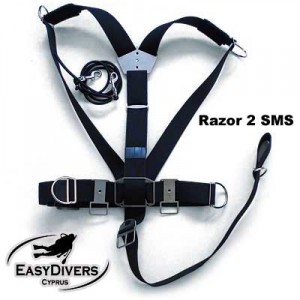 The Razor 2 Sidemount Diving System BCD
The Razor 2 Sidemount Diving System BCD
Using the Razor for sidemount diving or taking a sidemount course , The Razor 2 was customized by Steve Bogaerts. I believe that his configuration does provide a holistic and standard system for sidemount divers, however it does take several dives to get to grips. The razor side mount harness is great for advanced side mount divers. A little adjustments and the razor sidemount harness is begginers friendly. The Razor sidemount diving gear configuration shares a few key similarities to the Hogarthian backmount rig 1. 150cm – 220cm long hose and shorter 60cm – 90cm hose, necklace (“Basic†sidemount configuration). 2. Single continuous 5cm webbing harness and a crotch strap. 3. Minimalist approach to dive gear and set-up. 4. Razor Harness 2 5. BAT Wing 6. Weight system 7. Expandable Pouch
Tec Sidemount Course Hose routing
For sidemount divers diving at the basic level or in mixed teams of backmount and sidemount divers, 150cm – 220cm long hose and shorter 60cm – 90cm hose, necklace OOG and gas-sharing protocols almost the same as in the Hogarthian gear. OOG diver receives the long hose, and the donating diver breaths from his short hose.
The difference for sidemount is that the donator may not be breathing the long hose when an OOG situation occurs. However, OOG situations are usually not without advance notice and the divers can plan accordingly. In addition, one breaths the long hose at the beginning and end of the dive, the most likely times of OOG situation. Routing of the hoses on the sidemount diver is similar as well. The necklace is routed from the left tank, around the back of the neck, and delivers from the right side. The 150cm – 220cm long hose is partially tucked into the right tank’s bands, brought across the chest, around the back of the neck, and delivers from the right side.
When not in use, the 150cm – 220cm long hose is clipped to the right shoulder D-ring, with a breakaway connection. The bolt-snap is close to the second stage to prevent dangling, but far enough to allow breathing from the stage without unclipping. If gas sharing may be required, then the long hose should be unclipped in preparation for easy handoff, unless it’s already in the diver’s mouth. Each tank has an SPG attached to a 15cm HP gauge. The gauge is not tied back up to the first stage and remains flushed against the tank.
The handwheels are positioned on the diver’s outside, and the valve stems face inward. The first stages are faced up (towards the diver) and the SPG’s rests on the tank. When the sidemount bungees are attached to the tanks, they rotate 45 degrees placing the hand-wheel in the armpit and the SPG between the tank and the diver’s body. This reduces entanglement and keeps the gear streamlined. To view gas, the diver flips the gauge up from the outside. It is important to note that sidemount tanks should be considered your primary tanks, and set-up should not be confused with stage tanks and stage tank configurations.
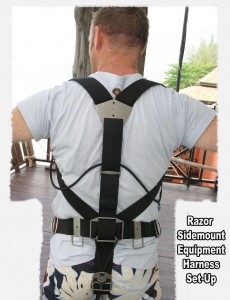 Tec Sidemount Diving Harness
Tec Sidemount Diving Harness
After a couple of years of field trials, Steve’s harness is complete. He has dubbed it the “Razor Sidemount Harness.†Unlike the other sidemount harnesses currently available, the Razor is extremely minimalistic – A single 5cm webbing harness, a separate crotch strap, and two small stainless steel plates to give the harness shape.
To hold the neck of the sidemount tanks, the Razor has one continuous bungee with a bolt snap on each end. Custom sized D-rings and two special tri-glide with an attached D-rings complete the harness. Each shoulder contains a 2.5cm D-ring. The smaller D-ring minimizes movement of gear, and is the attachment point for the bungee and stages. In addition, they also function as a temporary work space, similar to backmount.
When not using a helmet, I attach my backup lights to the shoulder D-rings as well. The bungee is an in-water replaceable unit and is attached to the shoulder D-rings with a small bolt snap on each end.
The custom length allows it to be as tight as possible, keeping the sidemount tanks secure to the body. A primary cutting device is a MUST and is attached to the waist. Waist D-rings on the side of the body secure the bottom of the sidemount tanks. This is similar to carrying a stage in a backmount set-up.
The significant difference is the Razor uses small 1.5cm D-rings. These very low profile D-rings reduce tank movement as it limits the distance between tank and diver. In addition, the bolt snap position on the sidemount tanks is different than a stage tank, and this further reduces tank movement. Additional low profile D-rings are positioned between the hip and diver’s midpoint. These are used to secure butt light tanks in a horizontal position when they start to float.
In reviewing other sidemount harnesses, the Razor is the only harness that has this feature. Weights are threaded on the harness, generally on the back waist or on the back center piece. If more heads down trim is required, then weights can be placed on the shoulder straps where they exit the Razor’s Delta Shoulder Plate.
The diver is weighted to be neutral in water, without tanks. Tanks are kept streamlined, and no weights are attached to tanks. When the weights are back waist mounted, then triglides with small D-rings (Drop Attachment Points) help lock the weights in place. However, if position of weights makes DAPs location non ideal, then regular tri-glides may be used. The Bogaerthian method mounts a detachable flat pouch to the DAPs.
The pouch contains backup safety items as well as wet-notes. Backups include spare bungee, double ender, zipties, and a 2nd cutting device. This set-up is very streamlined, using 2 attachment points with double enders. The small D-rings can be used as additional holds for spools or reels. I found these triglides with small D-rings very convenient as a temporary hand. Others use the DAPs to attach a canister light. A butt mounted D-ring is available for additional space or longer term storage.Primary and exploration reels are best stored on this D-ring. Personally, I chose to keep my contents in thigh pockets.This kept my backmount and sidemount configurations even more similar.
However, there was a benefit to using the pouch, as it can be detached and brought in front of the diver. Then an item can be extracted and the pouch returned to the back position. With thigh pockets, extracting items is by feel only. In addition, Steve notes that thigh pocket access becomes more difficult when carrying multiple stages.
My short arms don’t help, but this is something I’ve worked on in BM configuration. The Crotch strap serves multiple purposes. A smaller canister light is butt mounted on the crotch strap, and a larger canister via the DAPs. With the crotch strap on top of the canister, the canister is more securely held in place. The crotch strap also contains a scooter ring – for tow behind scooters. Lastly, the crotch strap keeps the harness snug and can provide a tie point for the BAT wings.
Tec Sidemount Cylinders
To reduce any chance of entanglement or line traps, tanks are streamlined. The only connection point is a small bolt snaps attached to a line, held in place by a hose clamp. The line is as short as possible, only exposing enough to be able to cut in case of bolt snap failure. The left tank has one hose retainer. When not in use, the regulator is tucked into the retainer. The retainer also serves as a back-up attachment point; in case of bolt snap failure. The right tank has two hose retainers in the Basic configuration. The 150cm – 220cm long hose is tucked into the retainers, and they also serve as back-up attachment points.
More recreational divers are discovering the advantages of sidemount diving scuba cylinders.
Historically, sidemount diving was for extreme, technical divers who used the configuration to penetrate small sections of caves. But its adaptability and advantages have been discovered by divers of varied experience levels, and that, coupled with advances in equipment and greater availability of training, has made sidemount divingan increasingly common application. It’s not just for cave divers anymore. Sidemount Diving gear configuration, which a diver wears a tank on each side of his body instead of mounted on his back. Sidemount tanks lie parallel to the body, below the shoulders and along the hips. Since the tanks are not connected by an isolation manifold, as they are in a backmount configuration, the diver has two separate and redundant sources of gas and will breathe first from one tank and then the other, switching back and forth between two independent regulators throughout the dive. The clips on the bottom of the tanks are attached below the hip, and the top of the tank is secured with a bungee system, which allows the tanks to ride along the side. The advantages of sidemount diving first resonated with advanced and technical divers who realized that wearing tanks on the side of the body created a lower profile in the water than traditional back-mounted tanks, thereby allowing access to, and the exploration of, small spaces without disturbing the environment. Less silt equals greater access. Wreck divers discovered they could push a tank ahead of them into a small hatchway by simply unclipping the bottom portion of the tank from the butt-plate. Cave divers saw the same benefits when working their way through low, overhead passageways. Reef divers, too, implemented sidemount diving to improve the navigation of tight coral canyons while hopefully reducing unintentional coral contact. But whether diving a wreck, cave or reef, every specialty recognized the safety benefits of sidemount diving. A sidemount diving configuration gives a diver easier access to tank valves in an emergency. Some divers carry sidemount “bailout bottles” specifically for this purpose. Sidemount rigs make it easier when divers need to swap out extra tanks staged along a tagline or the floor of a basin. The position of the tanks also gives the diver’s head greater range of motion for enhanced vision and comfort. One final advantage for sidemount diving enthusiasts is simply the management of what can be a heavy load. Considering the average technical rig weighs approximately 130 lbs., it’s easy to see the appeal of a system that allows for the placement of tanks in the water ahead of the diver, allowing him to enter the water in nothing more than a basic harness system. The tanks then clip in, but with the weight burden significantly reduced through buoyancy. Of course, when the dive is done the process is easily reversed, allowing divers to exit the water with the same ease. Older divers and petite women are two dive demographics increasingly embracing sidemount diving for these very reasons. Sidemount diving configurations are proving a good fit with the increasing popularity of rebreather diving. Because of the cluttered front presented by rebreather hardware, the side-mounted “bailout bottles” provide an unobtrusive way to carry an emergency air supply. The sidemount tanks also provide a ballast of sorts, creating a more streamlined profile and manageable centre of gravity.
To Train Sidemount Diving or Not To Train Sidemount Diving
Like all forms of specialized diving, divers should seek training to learn about sidemount diving. Experienced technical divers already accustomed to gas management and dealing with multiple cylinders and the rule of thirds will likely figure out how to sidemount with the help of a good workshop emphasizing the ergonomics of the system. Even then, it will likely take quite a few dives to balance the rig just right and to make the operation intuitive. Every diver must decide if these adjustments are a puzzle to solve on his own or a special skill set to hone with the help of an instructor. Divers who are not technically trained yet want to get started in advanced diving with sidemounts diving should take a structured course. Proper training will include removing a bottle underwater and swimming while pushing the tank in front of the body, donning tanks while floating at the surface, air sharing, gas management and deploying a surface marker. Working with an instructor will help the diver configure the finer nuances of the rig, set up the tanks properly and make sure the trim is correct in-water. Courses are typically run over two days. Divers should choose an instructor who is familiar with their intended dive environment. There are differences between sidemounting from a boat or a cave or a wreck, and the best instruction is scenario-specific. Divers come in a variety of shapes and sizes with a variety of needs; ensure your instructor is knowledgeable on the various sidemount options and can teach you what you need to know.
How To Choose Tec Sidemount Diving Equipment
There are dozens of sidemount rigs on the market; the diversity can be bewildering. As with all sidemount diving equipment, it’s important to define your own needs and fit your unique body type. What works for one diver won’t necessarily work for another, so do some homework before buying. To find the rig that works best, a potential sidemount diver needs to do a thorough assessment of his dive environment and understand how personal body type and buoyancy characteristics affect a rig. Don’t try to squeeze custom needs into a “one-size-fits-most” configuration. What are your rig lift needs? Do you need your rig to be easily adaptable, or do you need one highly specialized for a specific environment? A cold-water diver may wear heavy steel tanks and need a rig designed for that environment, including a wing with enough lift for the tanks, materials that are cold-water friendly and adjustment points that can be handled with thick gloves. Cave divers in mexico or france may need something entirely different, and deep wreck divers in Cyprus may require something else again. Pay attention to safety features: Do they meet the needs of your dive environment? If you plan to sidemount diving from a boat, you should make sure your rig is designed with the proper safety clips in case you have to enter or exit the water with the tanks attached to your harness. (This can happen when a boat encounters rough seas and transporting the tanks one at a time, unattached to the diver, can be difficult or dangerous. Rather than stress or snap the bungee system, the diver uses the clip located on the neck of the tank to clip into something more robust, like a harness D-ring.) Divers planning to squeeze into restricted spaces with protrusions need to pay attention to the placement of the inflation hose and bungee system, along with other potential snag points. A butt-plate tucked beneath a wing would be a potential problem, and the inflation hose should have a protective sleeve and a low profile. A continuous, one-piece bungee system is not necessarily considered the safest alternative; the prevailing trend these days is two separate bungees. That way if one bungee is sheared, you won’t lose control of both tanks. Keep in mind that safety and redundancy in advanced diving is critical. Both recreational and technical certification agencies now offer sidemount training, making it easier to find an instructor. More and more sidemount divers are seen on boats and at dive sites; as part of your due diligence, ask their opinion on why they choose to sidemount and what safety features are critical to the dive environment. There’s a wealth of information eagerly disseminated amongst those early adapters of the equipment. For while it’s not necessarily mainstream just yet, tec sidemount diving has definitely come out of the cave and into the light of day.
If you want to try not just any dive but may be something unique to you. Facebook Padi Sidemount Diving Cyprus
